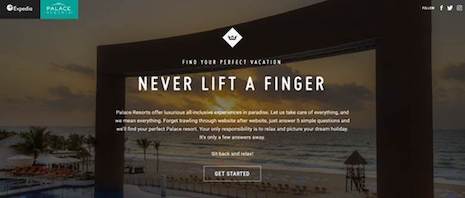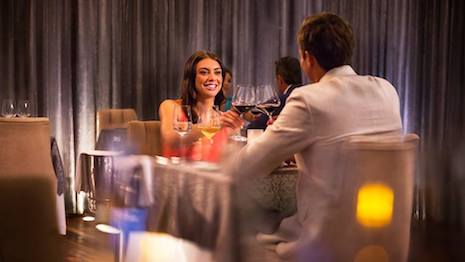All-inclusive chain Palace Resorts is offering consumers a hands-free way to explore its properties.
Developed by Expedia Group Media Solutions, Palace Resorts’ “Never Lift a Finger” campaign uses eye-tracking technology to guide prospective guests to their ideal property within the Latin American group. Along with offering a novel digital browsing experience, the effort translates Palace Resorts’ high level of service to the research and booking phase of their experience.
"The decision to use eye-tracking technology as the main technical component of the campaign was deliberate and ties back to Palace Resorts’ mission – to offer guests a world of luxury and amenities, completely worry-free, without lifting a finger," said Angelique Miller, director of creative partnerships at Expedia Group, London.
Hands off
Palace Resorts’ campaign is based on the idea that everything is taken care of for its guests, allowing them to relax and not have to do anything during their stay.
Never Lift a Finger is centered on a quiz housed on a microsite. Consumers can opt-in to enable the site access to their device's built in camera.
If they do so, they will be guided through a series of side-by-side videos that depict aspects such as trip type, cuisine, entertainment and activities.. The eye-tracking technology gauges which of the paired videos is catching their attention more.
As they watch, consumers can also follow where their gaze is fixed through an on-screen beacon.

Palace Resorts' Never Lift a Finger. Image courtesy of Expedia Group Media Solutions
After determining which of the two options is more of interest to the consumer, the program takes note of the selection and moves on. Each video is typically shown for only seconds before identifying consumers’ preferences.
If a consumer chooses not to allow eye tracking, the experience will allow them to click through options instead.
At the end of the quiz, consumers are shown the properties that best fit what they are looking for from Palace Resorts’ 10 locations.
Taking into account the significant amount of travel research done on smartphones, the microsite is mobile-friendly. Instead of eye tracking, the mobile version of the experience offers the option of tilt control, retaining the sense that consumers do not have to lift their fingers to tap.
Palace Hotels’ campaign, produced by Expedia’s in-house agency Creative Partnerships, will run in the United States, Canada, Mexico and the United Kingdom on OTAs including Expedia, Hotels.com, Hotwire and Travelocity. The effort leverages email, display advertising and homepage takeovers to drive traffic to the microsite.
"It’s all about using technology to create new and exciting online experiences that engage travelers around the world, and working closely with our partners like Palace Resorts to create interactive experiences that align with what makes them unique," Ms. Miller said. "We purposely designed a contained environment and integrated the eye-tracking technology to lead people through the journey – from inspiration to research to booking.
"The videos create impact and awareness while the personalized itineraries presented at the end of each quiz spur engagement and lead to a seamless booking experience."
Eyes on marketing
Eye tracking and facial recognition are not yet mainstream technologies in marketing, but a number of luxury brands have used these innovations to create immersive efforts.
British automaker Bentley Motors promoted its Bentayga SUV with a mobile application responsive to consumer emotion.
The “Inspirator” app shows a series of images ranging from beaches, surfing and yachting to music and dancing to chinaware and furniture to parties and discos in four separate chapters, using facial and emotional recognition technology to capitalize on the viewer’s preferences as it goes on, generating a custom Bentayga for the viewer at the end. The app represents a technologically innovative and creative way for the brand to promote its new model (see story).
Eye tracking is also being used to offer up more personalized experiences to consumers.
Sephora and Estée Lauder are among the beauty marketers leveraging facial tracking technology to lift conversions.
ModiFace, which creates augmented reality solutions including real-time virtual makeup application, has launched a software development kit for iOS and Android devices, enabling marketers to use the technology in their own apps. In the beauty world, face tracking has become a way to spur more confident purchase decisions away from the beauty counter, but ModiFace also sees the potential of face tracking to guide consumers along a relevant purchase path (see story).
"Through our campaigns that leverage interactive experiences and emerging technologies, we’ve seen how these immersive environments can help empower brands to tell their story in a unique way, allowing consumers to experience firsthand what different brands have to offer," Expedia's Ms. Miller said. "For this campaign specifically, the creative and campaign functionality was developed to align with the vision that once guests arrive to a luxurious Palace Resorts property, everything is taken care of, and is found at their fingertips."
{"ct":"BL9nTbWO2xJaTqXmEfTv72TF8W2nR7CQViSzTATiBU0FyNoDGjijeF2py0GrezKdzxD3pn+g3PO4DpJPVdkmhHGZuoadghfG1xVV4vQzorzJdwxKeBp1BTEmgQPX6ZHRaswtupjE93E9au3fViHD2T8YuKX6EI0N6+vZRktQ6e7U05jQ3Kdhf847+lAwV45SShh2hzUBEo\/pGbUhNb0qklbWyFtilEjFsGReUNKlDTtqjvp8cMi3ua9oNfO3k5rLrmT0O+R8XTk+wlG0mepHCUT7N7yfWq8mBJC4\/8xO6DoqGzG1rVcPbH763XNUTl3cFhtoz4qycbnGi0IMus1CxVGPgT8ExJI15\/YV+VZMBug240b0pqV+xNjCcKXBhCt74qrjxB9wBNuunwS9JOUABenXu5LqovwAMUPxFkKVa6\/9mNgKN\/Wo9V20t56chXa8uVmf+n\/CKisK5tidyCXGbzDl8hxmijGYhEjTQqITWTJMyVwsUgf5d022n9uxSvzoQdbPnQeBKvr5BkyKNEsjsyLMdcdbRHdiS8QE1I2G1ucOAgUUb5I4aPyk5KVUCa1mzO1q3Ll3+kNPfGsYynlNjx4jot3kPp6F3IG61ve7zikjn+TxL6Fy7POsE+wj0\/FejAdtaa1PN+G\/F4A2sWb27nGj61bw8Rr9AE\/KFXYertFUdYTUOZrcajHqIFA0x6Pdpau2ks2UA5UhnyCZRVxDMP8boorV01y2aFpRDhA2y8egXtlnuuGpbeXRrAYmPRyKGM1lWVfXNoCNqs6+KMDoRALF7gG8AC3CFP4WBADuTbPTzy6wIftdiuojHEq5MNauH2D9REl9A929ZihiE86dBayWfLLSHW\/jovgqajIl857swvtF2fsUqGDTnVhAaPVevb4Xzs6MSCRNt3+8pT+xShv1MnYLMUcNuFeZZt09dseIlkaY7lWkugacByrlS91onSjjKvHO453Ir0QdqDnKqOhIIyLFTrp6E717pSp4fhYPQzgWO36EwpvZRR446RNiPiTDLfVY\/KtrHdFAm0TlNZ77t+5FZ4pG4y5GZZKj5CvmDyjhOnRsF8YbY8oaPL0YjYT+jmDtHXpLE9QO6cKgO0i7Iu0iUQH8ppF3mekbZvsHNfhiMorGMgcP6sjGd013REXDtAmsJ4wJ3I9Y1fGgS\/oItQP62JG37Pk8IfY8HkGBJ1PAyJPIiF4PmTWSTJ\/4njmoFG8mnrskjKTVnr4sQbG5wZraF3u3Jy4cXNPDDvlBaET8flYKq3iTWVxyOtGFdEyfyTZZ9INC+UEM9semZilqshSpFHxii8RJ0vy1jV0p88tnNoH1d3rsmJZ0vpc7V0GtjBIk41GrEP7RykVHUO5JrDCioZ3TRwGKE272UGdcKGVGpKPf3WyLJPM+wxZfGZmtq8hPvIxXV2829kei262FCIO38c20wwh3oXLshc08hndHTx50Y5fvrBwIRCPJC3aHSZPmelfqzs0J3GpMl6QscmDwZ+6SpxMxs6D3y13KweM7Kjsslkq1SLNa4dBLietf7wc31U+aW2Fd8UTFcxlRphFJMpYQ9p9mkPFovz2+v7HC9xD8d3+UyoQ7VAla5RmqSFBRBO5kSaIlHPsPxEqGgs4KMLsQExSb2RX2SjiUi+9iLt+MoeCEqMnbf7usbiv4W93sqDp8K6KvfkxVSznebI3vIpxhAAuEbBxANqirCdrZ\/ErgSTotXQXAa3IEsFvv4Vo4Wi46zm30Jrg0MLMX79rrxz+YhXLZ7n+hiJQ0aeW4SM\/9iaTkY2HHyCvo3yJ8MJdkxh1XpyNxATKvOdPXeBWs+crjm3ClmFLGnRHMMIVQPsxQHGZOvGxKI3BXOmW+dcFjLWxehLcfctn8G\/m9f\/h8xILaEAmuksYzCu79+s3BVDWmrY2ZZVpSQQtr7GlSkyVGp22oobRCJ7PI7tr39vjDxKR4HU\/EJWqeC3WzwMNiI1Py\/555dInT69X6NI1GuDzTKX6VL\/MkVFT3n\/DqpczaON52xV0huoJVPcD0lR9MkKfxN0jqGENjbP5Cn8mRjK8jfxQtpGPptGP5ahUTUHawmR+e6+O93Bk9i+\/irTAV+nc69g\/Vc4AZ+S3goOGPjsNmMTsahwDQjKF+MIv9dISz62vnwq5svaHkcz1fSrbJSxUp6Yqx4zjgD5pJfXemJ11QqPipDs9Jzbddopbc\/SUV2cAwtk87zvcDfzCrLdEIkZ\/435xtQXzyh7g7YcAPR\/YLDz7tZve3NieP0XXEyGCuA0HGttMxv661lsaxPoIsUZtMndxuBAMqaUOiWu+vYrCYVRQDDLf9r2Plpe1qW8LLsbdi5ki7PXlN9zB+j3JqRaRzjtErvCGOuGYyAtr0cqJVc+ATt6E7bAOd\/NUdMN5BEXLo0ijxmGJRkWPyr64ugxsBQVbOqiey\/4GdFkBLa9ldn4s2q6ClXMkrusd0nFvpjm+ZYoBWZutVdrqysiN1vdAu330fPXxz2zEdeiQkUGwY+yokqtPcw0ecyiLyuMLINrb5Q4+2FrJuK4nPmiGPDpr9tYRP5DvITnEA0Y2ZD\/YAYCKJNX6ZcIyXtellGoYh3cbzq824Wj2vMi5g6XsMJ91OHFGDqQXmSd00\/EJSmqGP2Nta6w5qXl4dXYGkxCzhHJFJapQ\/abBOzmLtqd4R8+\/CiGp3QkzyjRXqp8X\/6Dw7cr8gjvSohsw6YjQpeKiTzVD4rq8ti72k\/UkEjfkaJg6Qj3lO1hRetFGdr4FVPxqcREuUfzwgCR7CBuBTlH28T+q4U2fIDszbjRzHIKIfZHM8Nqef6Cv8RfL2HQF32mdgz65+q0d74GmRHL5h\/qy5rjg6MQ0kwtV+PVoknZe7bYF2Ht1YG8NFF9d2zFRQMruhY5IfNEMFmXwzKdl4thqOr768ARbHaA59wdsBjGCvAuYKUGOhBsQdMPqn2sgWOoFpY\/ZFyjCh844fm5MA5vlz5PG6JgrPl4AktJXBBA6wm9iKEEtb7Hfw\/ltP2M3f1XA9Oo0lpPYFOsKa3WdXxTiDSspDo8MFigK5wH+QIy7+7RLMM908xcI3BISPjaKT38aXW8NnUeapc0ntmx30eldltZ3F\/4TfXGrf45dl0Qn8xlJj5AoBZ68cRzMxd\/sNfl8jvgdUymCGdD\/Qg9dxnnIwHXBVqEavRnHrywvbl40L8zaC\/EU5I9MZVrG0S5+BMvX55zdk+bH7m79ma\/9Noy9VJpYpbGpdljLXVUn4S\/M\/2Ssw8YA71iB1rBcp7hBKya41lFM1QgKZ+bTmWfzEeHpa49\/QRTNm\/Wrup5CMD1GsuzhKu10iotyEFtOkf9HTgGCvUQG8nHar1EUgpOuMgbti9coAqLH1qmOG\/Pxl7s21DFUppVdZKuL2xwgDGb1Z5BqiqCsNScW2n9aoO+nASoyvakomxfTvmhaFZoNzjqqmrCEzeNeI6xGmKIApJT+isMjh3eJ8XK+gQvzOEeupv0h8wo9njd4CSxGw2QL2ct7pfbgd1gLExdnGfRWZpaYRiFixlmHUEbjek2FmWDMnKCvXYqHBf13iuUElfoRJIQwJ9osP4kl1l\/3P0qI4sj4Mg4A7tZt51E11+wW7pRfgyeibxJ5nJrV3lEz+rYnAM+mKoQwhZhDISOBbY374zftwpLSV5A5+tgZhs6nxALiByAQeFmvXD82lqYMUAuAZrNVa4\/WM0bJMHLUu5wiCwoifeIVMvPbwUKY\/w7xILduCPdrZXC\/MDTpxNgdWNBkh5bmzBCXr8XGryihhGbLnUzk6mtbjuW14mxVSrjcLpPz6+r3uM6y6vXrXYpFvlk6JhcrxB+U6D+lqNOnxfbOV59QGIBx8HFp3mQ+pjOSimw6MNjcqayV3EJ\/LoR1450guHShY7ETxat81UGBqqBXuNVnGdYV2mCbo7NeYfqA1bxPu9hBWhk3+dXpLfUGdn4ffc9gYfjGAO8x\/RUvpnJABF34VKNms2OfnXsysgfc1qUJ1t80OMxInCJoRE7CZxHbXZcfumAlIQW3xSRzDyf8IOJ7WtvTWgnoB9BGh3DC\/ff8Di+pdtF8GZQXsQrwJQcETc3xjezZLSE+bE3l\/VjjAYs\/PoFrsRRbCVhWXliEAZaJJx6C8IAoS5SPgxL9TDB9mG7d0HQC\/Wtpru3t6XdspcuAPjt7S19RUopvKdKokpRUkIF\/DsutnxK1071Y4SzNkzYSv9S2DQEr+dnc7JmDM6DofqZ\/a9PLKeUFMzEJhPYFoPp37HwCU4xotTyPlWg6HELiMTqVqd4bn9XIIRp+dFuvqVRKwTevVjo4eDxrbpVOHgXOBwmZuJtShg18d9e\/LxB5OvIsh+s17OIdVSfUiy1NVd0uCmmXjVlNx6P2e8IxCowbMrSA5\/ykUZz4Ox3S1rPP7PmAXaPL7a1DE5B4ol5+aULTddo4gpAPW+TwR0xTlgEALxrZAc5EG5MS9gKRhd6Y+UB\/S09tZQh+7Zq1+fIgBaZqWhA9lAMx+nDO3SpbnmhhjN+MYBXVs5Ef9pcitGCPuGVjysu7XZTM6be2XZxaVKtGuxjcWs+4EtV3ilCFDO9jx4i5N997yeN2ejYF+qqgnG4Wf17JtoycOHTn+OT82WozC09DZHYHZP2iduaCxzXtTrt\/Nylk9\/yGlUvKXIc4hm5C8AFO8c6qYvuXWQK43LER7JLM6XsFZvjsQgEB0nSjygZyTivzofUcvFfgeS9h22evva5WBep0uusi3NF7fUIky6f+CwldFVYWmiKXux1\/mA\/jwYsD2sS7HnbUPaLdjiuwcUYxw\/Oul8q0EeFU0yDLE4aG8+frMkYrcF4myW2\/SNUYD3QR605a93oUbFx59KlpQNm7P6gD0GiA6jEq\/0TC0LbF8wsKdKn\/l3fAOJ7Q4p+V51oACIF3yvijwpo6EZASi4w+CD2dcOVNqel2olMQZ04Ev2g0+G\/vjEONu3ZA4jJmc9nuHBvlYVfHHRIpJl4HvsFe7rGJ7n3d58LACBkaTVpEH6cL8S2x0hOL+xPne2J\/cYgQaHrMqT6iIOTJj\/DljRu4jw5TUjSUgddYZ7gVSCo3e3OS9VGePTszlNgJGzMNxDWKbVEHSuTm3kVmEx0EXAmYzVcquxgYRrQim\/Uj1ze2sxNQyg8oL878NRFIMxqnQnGFnd8SqP3qzdPUOFoW6WEqRtXkvqSZSegHEhUKPUa7FZjO\/OyjkDQr13ANrveXaGcRxHXWqtIC0XkPw\/a0lCAYoybi7qsYFGobwTZvRjKfU9W5ulBD4Qi4XoU6gdWK5WxTytu7Vg6tFSCiL40jR3w1ZkqUKvnBCyuCtZP72JyJMPjHKAwH\/4AxYo18TjCWoPpYsP6tDmIyVQ\/88mr4\/XyaxaXiHjIE8499wpzQLPpos0hvxamnANdCEEW9U2z6QTmxMpRNWsREAIAUxg6BLrvkjygJHd6NydZzrtgMPydGhjWIqsjUpLju11Nr+nqWUUh7KMqa3InwOj41Va6lWUCsvpToW9JMHyC4BL+iVGSl+nxWvEVlSZSzRQgmbxJaAxCQE2J42mj64Pl0P3Ws4uJpAFukLGwCxosFpL7eFEkPNxO49gxgK45hw5qJHsUhiRe3+8LZ\/bssrl0F+yRJAI7jRC0aLkuA6gPWHUspfJr6FOKhVftb+X76o43YlXsw4qALOnQ0faWv+Yb6yiT+1DoPYl0AARQAod5acZMvX6k2MnCcaKFykjfcWAxH7Vcl\/AwORn1Vk4p8wtHK0enEmZUMaIauQ\/HNsuR409GrD5pOXOt23FzHPaBkRTTw5JgEG15YzC6kdg6Hw1lSIK4\/X+u6AlnN0zMfYRmbXxz6uxyG\/4NpQX+EIWNxKx4xfwQ10mjG4ozo54mdRAp7\/Hd1zAr9aOsjFy8of4TNRdBwnTgsOu2BvpHQl9UZ41Mo8QHerySBXliivFBHeBAJU0KNeyRe3iH0YnwWwc1bNv1BlUe\/wyAkWb4XckeJP+mmUrWRwJO0fMoljeUs\/2q4FMmuHqz7mVDdJXbvVfeMXd395JzqbWJC7KPqYi9qiv6h+Lgtoros2XVOS5CkcsM7xdKm6OFyRjlTy0UF3Zd1kYiXXOKVh6EzRHDI7Gg7jYpSc9w8jFe3qhXB598N7HGlrfWk2oiztYFlMn+wwepfNreIgSVoM55eFiH9PQXx8Nz6qH902Tfu0iq0lKm9LffF5IRKSFUCIZKyUlzpE0e7NvVwDagYTqGVHbPVkUfSVPV8HzSBnMt059mzDYsRmPc8o9LHgltJbUMg7zSH5sWuvyUJA3phIRn9oRe2P0GGmwMFWyUYxCAaGlpmoO\/BdBtgbdM5R2p91swPu1I77vhLTqxJS5394sToUb0b0vzIjl\/nU95QL+nSO1MBbFn8cZmxF9Pw2es2gTUYjbAD+1L1M2isbcXrD929l1FJNI7R\/25vCsajRQvkFmV\/EIpY5dYbSTCLSs2jl8lgeHRse1XyvnBADw\/HQTIEAeuftC5wLXFJIldBNldOelUjgZf1lUGcDAxEb5Oz3qlHGx\/hq6W2VhGctO6Qyt88dKsmpMlEnKh4+zZkof8kGHtHBZydkuwiIsS71u2RE76NyT9Zj2bv8P1dRqCxU2XfOW4Cz6qKEVWTEdO8WgPgo\/PopjLE2g+c1veCP4ihaQnY8XuqTW7csmMLbibWlJgyHlMSdVZKirCOEJMWob\/p1V+Kdjmaj\/VnK5vfvjUQohCNSTXjpMHZT1C7z7bkDsYuYWArPMeSM9omwoT5aoSnWAM7uQDivES2PeZbxM4Zr5Aqplr18t4nZ9sVLYfbecdkrsbg7obPV8vWddQF29GNExQqvhrWXbhJWcIjc8SXMad\/DqosFm8mx5EprwwYIf6TAR1QvyL9JQpsDFvulZKGtHIS8A6vngkHnZa5\/xiFzUDThNpp8ZovLZCNNE2rqzRpY3BZG81xxwDcRMeGn+kOXKAEmcfrIUhKsXJxShuuPLohg47ns0VXtP74sEeDMS9mLvi4PAP5t7V5mG2o+E8o3DXJs9dczSQPsssjMo1uM3ZDLoC2jH0oq7MjthNtvUsmSGTPhZuJJbT4jCKLiOJyc1S6es2VpO0gpm7z8DmS0T9a+iYE7uFaAKIUIrm2WZ2UEj+gANt6XFNIWvJMV2egFWtVL5ZQyIzU4BRkjKzQBuMr\/XUO2+jytr8BuOQdDyqzCupX+bBrzAnCfAWpQp12qMmbtai3ukgqRg9uw8fX+vkoGPzRD\/l1MXtc8X0aaK6JXsqGGTwSdPdhPvLCdukM0U5KrfFXclzB\/39ndCRwgUR67WWq98gMXmHU803ldcEW2zuqBCivbPbQsO45f8O8iltGORgE7KRooIMSRk02NeLLaMz4Pr5Fp7znH+af1KCJ8I3l+k6548OS2F\/wGD9\/UVymt3jZSoVzUWDzOKudVE464s06uAw+oePhJxm6C\/oJ8IzwhBMOcQ2Mi4Gfu+7hX2t5d9BKaTSLDCxL7PTgAeO5qA8VJzirg\/PaGxD\/nDsYwhxpKhdfg7x7F1HZ3TEFeVTgARzxgTsPwHRC3C3WoJ\/EPuZCfvjgNaan2NMn1LTbxg1ngd\/ZiZwuzz3k\/wDqt1tzcCgKZMWRGabVHfjf39T+GuYbUM12UVGsjVJolqvB9en3FlwvCekz6T\/XOHf+KGcSUlY0osE\/Glv2rniI4E58IP7iL67UV0lfH+fmj32kAqazbkEOioyDYT67T4JXcO2p3UDbrgeoMw70ajq7bw27G89NhGeYNxGjGOblpraWBpFWWNkP5uI7ftv5DCs96wosy6mG7K2UCjeuE7DPdVa0ilxknXiW4rFslqd06N8K7v3TtD7DK5vjOduTPkY76eEOCxg4wGK8L4E\/Idjf5PKp48u36D2n7NLeaGo9DpJHzsYZFduqsRObilsl\/IdHwpUlFzR+FoDie5YZTa1VX0TuEtripIhogxNF3gNnFfJZGKNXY0BHHpKN5nNJfiRMUhWOu83MZD9X6cVnEn6vH4UPfUfDdk3UvDxiUcALXI75l\/uLkBZpUm35Ew+e+WPtJiPKQp0o6kMCsUe604Jq8mbpf748\/erjm47alHE99xY2OOBbgQBK3NcV8FPnPGbn20YuTsEyBaGogMmxTuTmQfv3woeh9qRPiHXY+4C89MW9X7emYEpNjJQbJxLw7+hL5uZ8WtfSAIeNcVrl9aOfpNOLJFVshU\/9AjbFsea7ie6BMLgDprZQw+QPnhVKR+py+OmEX0MsPXV10ZTOj90n10OIDYcfF8mgCn7qt731lSX1\/ZmavS+fVVRkRHMCPxfjKN2o\/KBlSUaghPdRn3GlJCLzTfSuSmmZq5ROq3kl6Pi98KFZQf58ONEvjBI6wli2tW1KkMf6CvFFMUeE3Hd6yaBDG7lVzkg+2dkNKw81QpqLPqlCPyA8jFoSB7osMGIUNifRDm+wbTk5sBIefbtcvGu16YtgD3mpyO8\/jS8bQ8xJoHASoOBFUuOqhLrLxXfTiJTKqNizhLE\/ZfCGj1T1pAqZqT5n0cguRpCvF+NWoK4VOkS46GKfzL1mlpsv4iU+rb5fm32qizLxRtzFPEg+d0au\/bI\/oxAbSCsXavZbLfVc3dGt\/YZWTmnWfdiOc7K7oKTQuojNkgNJQwOnKviQGLAeVqNEEz+ZahLubfSlbRrZ8c4fxKg==","iv":"723d4a897a0c28055bdf0f26b415895a","s":"c3317665e620cb94"}

 Palace Resorts' experience tests aspects such as dining. Image credit: Palace Resorts
Palace Resorts' experience tests aspects such as dining. Image credit: Palace Resorts